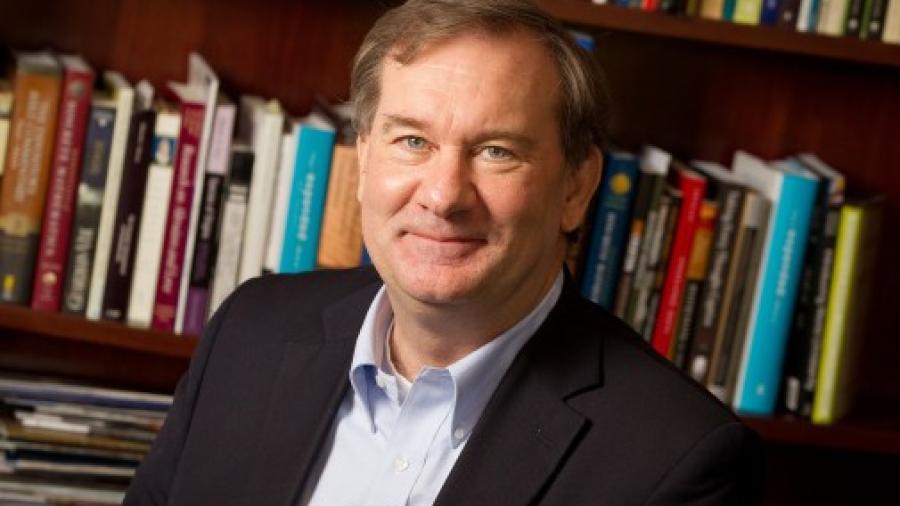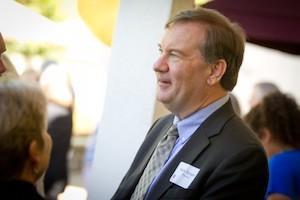Westmont Magazine A Few Words from Mark Sargent

The College’s New Provost Shares Some Thoughts About His Life, His Career and His Work at Westmont.
His Decision to Come to Westmont
For years I have admired Westmont for its strong commitment to the Christian faith and to the liberal arts. My family ties with Westmont run deep. My wife, Arlyne, and Daniel, one of my sons, are graduates. My daughter, Andrea, is a first-year student living in Clark. During the last three decades, I have enjoyed a special rapport with many Westmont faculty and staff. I have walked through the remnants of burned homes with Westmont friends, invited Westmont scholars to review our programs, and watched plenty of Warrior soccer games.
I resonate with Westmont’s five major themes and am excited to help develop centers associated with them. My career has focused on residential, undergraduate education, and I enjoy encouraging strong collaboration between academic and co-curricular programs. The Christian mission of the college excites me, especially its multi-denominational, evangelical character. Global education also holds a special place in my heart. Throughout my career Ihave travelled with student groups, given presentations, or conducted professional consultations and reviews in more than 25 nations. I believe a Christian liberal arts college in the 21st century must be passionately committed to global understanding.
The Value of Christian Liberal Arts Education
During my college years I often made long bicycle trips with friends along the California coast. For cyclists, few stretches of the road are more demanding than the Big Sur coastline, where the mountains press against the sea. For 70 miles the highway clings to precipitous cliffs, mixing sharp climbs and rapid descents. That stage of the journey requires full concentration on the thin white line along the road’s edge as you weave through the fallen shale and pine branches and avoid nervous drivers. Yet every now and then, after a long ascent, you reach a vista point.You can raise your eyes from that hypnotic white line to survey your environs: the clouds darkening the quiet ocean, the cypress twisting in the wind, and the whitecaps sinking into the crevassed stone.
The liberal arts are much like that slow trek along Highway 1. They will increasingly require both singular focus and breadth of vision. Few challenges will be more pressing for 21st century leaders and intellectuals than balancing specialization and wisdom. Scholarly or professional work often demands the intense concentration of a cyclist climbing a single hill one fierce pedal at a time. We may need, at times, to display the intellectual discipline to carry a single task to finer and finer levels of refinement. But we can also, like the weary and anxious cyclist, get obsessively preoccupied with the white line in front of us, on our own professional duties, scholarly ambitions, disciplinary guilds, or even the proprietary use of knowledge.We need to see our own labors and hopes against the grander vista—the widehistory of human endeavor, the diversity of our global neighborhood, and the looming ethical challenges.
At its best, the Christian liberal arts college provides several remarkable vista points. Our task is to help students lift their eyes to see, as we endeavor to lift our own.Above all, we need to continually discover the beauty of the world the Lord has made. The Christian liberal arts—with its diverse fields of inquiry— should enrich our capacity for worship and wonder. The life of the mind is inflamed by discovery and gratitude for all that our Creator has given us. Exploring natural and special revelation is one of our prime callings.We undertake that task with the audacious hope that the broad vista of liberal learning can help us discern, more fully, how to know and to serve God.
We also need to encourage students to see the long panorama of the Christian faith—not just current doctrines and disciplines but the tradition of faithfulness. All of us came to faith at some point along the road, either in a quiet, restful spot through the guidance of family and mentors, or after a tough hill or crash. Evangelical students generally arrive at Christian colleges caught in their own moment, within their own generational stories and idioms. They need to study the various twists and turns in the course of Christian community and thought, both the legacy of great witnesses and the church’s moral failures.We need to help them discern their own road ahead, their sense of calling, realizing that the conscience of the future is often indebted to an understanding of the past. In short, we need to connect heritage and vocation in our students’ journeys.
Similarly, a Christian institution can connect the future and the heritage of the liberal arts themselves. Westmont is able to invoke the medieval synthesis of classical inquiry andChristian thought, when the liberal arts flourished among those who followed Christ.We can also blend this with the service-orientation, philanthropy and pragmatism of American evangelicalism into an ever-more vibrant model of life and learning, full of rich texts and transformative experiences.
For me, our essential goal is to awaken the moral imagination of our students. So many come to us with hearts eager to serve; they also need minds able to imagine new possibilities for social and spiritual hope.The scope of learning provided by the liberal arts encourages interdisciplinary solutions to contemporary issues, often overcoming some stubborn preconceptions, professional habits, partisan loyalties or even counter-productive philanthropy. American Christians, for instance, rushed millions of pounds of grain into rural Africa to address hunger only to discover that their actions undercut the markets for native farmers and, before long, actually increased poverty and starvation. The humanitarian needs the botanist and economist. Pursuing justice—and meeting social needs—requires the interdisciplinary and imaginative problem-solving skills that the liberal arts can cultivate.
To cultivate the moral imagination, the Christian liberal arts college needs to bolster its commitment to blend spiritual virtues and intellectual strengths. For instance, fewer skills may be more necessary for promoting international peace and the resolution of conflict than charity and empathy, the spiritual disciplines of discernment and even forgiveness before condemnation and violence. Our students also need to see the vitality of Christian thought in the marketplace of ideas, rather than retreating into subcultural silos. Even as our graduates learn to live civilly in our increasingly pluralistic society, they also need stronger confidence that bioethics can be enriched by Christian ideals of prudence, stewardship and human dignity—or that community development and economic reform are enhanced by the Christian practices for addressing the spiritual and psychological welfare of people as well as their physical needs.
Few things kindle the moral imagination more than respect for other peoples and cultures. The most significant influence on students’ personal and cognitive development is their peer group. Recruiting a more diverse student and faculty community— socially, ethnically, denominationally—enriches the intellectual and spiritual climate on campus, as we daily encounter the perspectives, experiences, and faith journeys of a broader range of the world’s citizens.The classical image of the liberal arts stresses both an encyclopedic gathering of the world’s knowledge and a commitment to pass the cycle of learning to a new generation.
In many respects, the Christian liberal arts college is the laboratory for the next generation of leadership in the church.
The Appeal of Being a Provost
The lure of the provost’s job has always been its opportunities for problem solving. Actually, I like sitting on committees, and I do thrive on interdisciplinary dialogues, cross-cultural initiatives and academic and co-curricular partnerships. In time, I have even come to see conflict resolution as a source of collegiality and renewal. I have always wanted to be in the middle of the central challenge of the evangelical college: how to blend a life of piety, service, academic rigor and intellectual freedom. It’s been a good life.
The Ecumenical Character of His Spiritual Journey
My walk with Jesus began in my parents’ garage. My father—teacher, artist, seminary grad, and tile setter—leapt at any chance to make things. Our garage was a storehouse for invention: chipped ceramics, antique maps, Life magazines, PVC pipe, driftwood, rusty circuit boxes, scraps of iron, and abandoned lumber. Out of this curiosity shop he constructed time machines for Vacation Bible School or table lamps for neighbors. Nothing purchased ever matched the wonder of things found and remade. What I loved best were the fragments of colored glass. Sometimes we would scour the back lots of Judson Studios in Highland Park, Calif., or search behind local glass factories to find remnants that had been tossed away. Dad recut and assembled these into stained-glass windows, occasionally for churches unable to pay for expensive settings.
Those windows were my earliest lenses on the Gospel. My parents saw beauty in what was broken and discarded. I watched Dad lead one school for youthful felons and then direct educational programs for Vietnamese refugees. My mother, an elementary teacher, supported Russian orphans and assisted dental patients without jobs. Some of the tasks in my career that have most energized me—prisoner education, service learning, and hospitality for immigrants—are no doubt remnants of my parents’ dreams.
Just like my father’s garage, my own spiritual journey has been a little eclectic—or, perhaps more kindly, ecumenical. Raised in a Baptist home, I accepted Christ as my Savior at age 6, following weeks of listening to my mother read to us from our children’s Bible. Since then, I have worshiped in many churches—Baptist, Brethren, RCA, Presbyterian, Free Methodist, and Congregational— in the evangelical Protestant tradition, though I suppose I have always maintained a little Baptist independence at heart. That free will made for some angst during my early adult years, when I assumed that my conversion was little more than a childlike conformity. But today I think less about the innocence of my youthful conversion and more often about my need to live more fully into its promise. I now speak with gratitude aboutfinding Jesus when young, knowing that it opened my heart to discovering God more fully throughout life.
One aspect of Westmont that most excites me is the vision for an ecumenical community, united around the historic creeds and the evangelical spirit. Building links between the evangelical temperament—pious, pragmatic, and buoyant—and the creedal sensibilities—traditional, meditative, and aesthetic—was one of my favorite challenges at Gordon.
